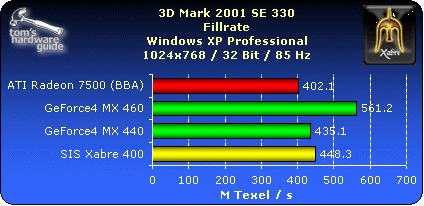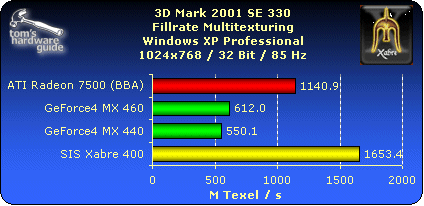Xabre Rattling - SiS's New Graphics Chip
3D Mark 2001 - Detailed Results
This synthetic benchmark gives us a lot more information than just a final score. Looking at the individual tests helps us make out each card's strengths and weaknesses.
Fillrate
The fillrate value indicates how many texels a graphics card can send through the frame buffer per second. 3D Mark tests this once for singletexturing and once for multitexturing:
- Single-Texturing: There are 64 surfaces with one texture each. This means that the graphics hardware fill each of these objects separately, no matter how many texture layers that card is capable of drawing in a single pass.
- Multi-Texturing: We draw 64 texture layers as fast as possible. This means that we take advantage of the fact that modern cards are usually capable of drawing multiple texture layers on a single object as fast as it would draw one single layer. 64 texture layers are distributed so that each surface in use has as many texture layers as that particular card can draw in a single pass. For example, if your card can draw 8 texture layers in a single pass, then there will be 8 objects with 8 texture layers each. If your card is capable of doing 6 texture layers in a pass, there will be 10 objects with 6 layers and an 11th layer with the remaining 4 layers.
In single texturing mode, the Xabre beats the MX 440 by a hair's breadth, while the Radeon 7500 takes last place. When multitexturing, as used in many modern game engines, is employed, the situation changes dramatically. The Xabre is a full 3x as fast as an MX 440 and still a safely twice as fast as the Radeon 7500, which also handily puts the NVIDIA boards in their place.
Get Tom's Hardware's best news and in-depth reviews, straight to your inbox.
Current page: 3D Mark 2001 - Detailed Results
Prev Page FSAA Benchmarks Next Page High Polygon Count
